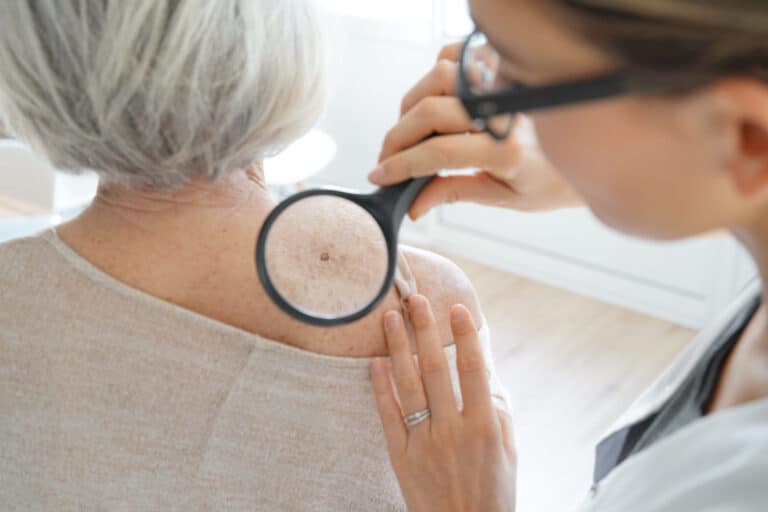Doctors track the progression of cancer using a numbering system. Early-stage skin cancer, specifically melanoma, is either Stage 0 or Stage I.
Stage 0 melanoma is present only in the outermost skin layer. Stage I melanoma has penetrated the second skin layer but remains less than 1 mm deep.1 These early-stage skin cancers are typically easier to treat and have a higher survival rate.
Here are some important facts about skin cancer.
Skin Cancer Is the Most Common Cancer Type
According to the Skin Cancer Foundation, one in five Americans develop skin cancer before reaching the age of 70.2
Melanoma causes most skin cancer deaths. Experts predict nearly 8,000 people will die of it this year. Melanoma only accounts for about one in every 100 skin cancer cases, but it’s one of the most common skin cancer types in young women.3
There Are Different Types of Skin Cancers
It’s essential to identify the characteristic appearances of common skin cancer types. Most skin cancers fall into one of three categories:
- Basal cell carcinoma: The most common form of skin cancer. It often looks like a flesh-colored or pearly growth or a pink patch of skin.
- Squamous cell carcinoma: Usually looks like a scaly patch of skin, persistent sore, or firm red bump
- Melanoma: Shows up as a new or growing mole or dark spot that’s irregularly shaped
Train yourself to spot potential melanomas by learning the “ABCDE” memory trick. A melanoma spot usually has at least one of the following characteristics:
- Asymmetrical: Unevenly shaped or seems to have two different-looking sections
- Border: Has bumpy or jagged edges
- Color: Shows multiple colors on the same growth
- Diameter: Longer across than a pea
- Evolving: Changes noticeably over weeks or months
Growths Can Appear Anywhere and on Anyone
Skin cancer is most common in fair-skinned people. It usually appears in areas with regular sun exposure, such as the face, neck, scalp, shoulders, and back.4
Check yourself regularly for growths that may be skin cancer. Look over all areas of your skin, including parts never exposed to sunlight. Although sun exposure is the most common cause of skin cancer, there are other causes.5
Early Detection Matters
The earlier you catch skin cancer, the higher your survival rate. The five-year survival rate for melanoma is just 30% for cancers that have spread but 99% for those detected in their early stages.6
How to Catch Skin Cancer Early
The Skin Cancer Foundation recommends everyone conduct a monthly self-exam to find early-stage skin cancer. Use a mirror or ask a loved one to check hard-to-reach areas. Look for new or changing growths, sores that bleed or change texture, and sores that take more than three weeks to heal.7
Learn about skin cancer and skin health with My Skin Treatment, and ask your doctor if you notice any suspicious skin growths. It’s better to be safe than sorry — especially regarding cancer.
SOURCES:
- Skin Cancer Foundation: “Melanoma Stages.”
- Skin Cancer Foundation: “Skin Cancer Facts & Statistics.”
- American Cancer Society: “Key Statistics for Melanoma Skin Cancer.”
- National Cancer Institute: “Anyone Can Get Skin Cancer.”
- National Cancer Institute: “Anyone Can Get Skin Cancer.”
- American Cancer Society: “Cancer Facts & Figures 2022.”
- Skin Cancer Foundation: “Self-Exams Save Lives.”






